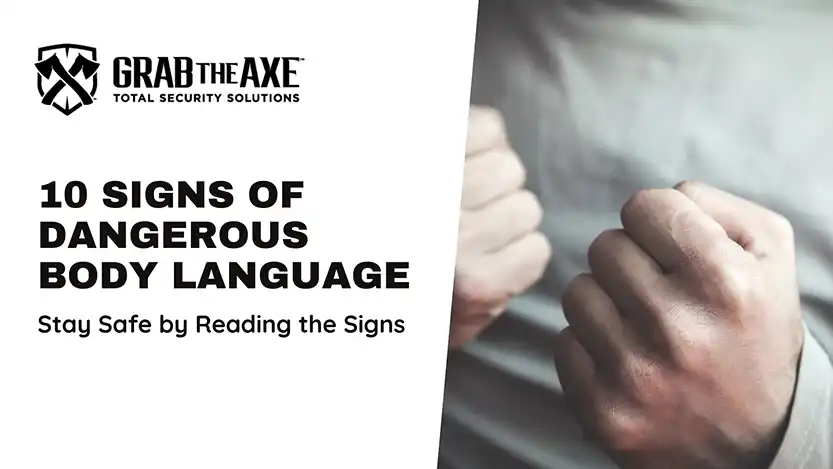In today’s world, personal safety is paramount. Recognizing aggressive body language can be a crucial skill for avoiding potentially dangerous situations. At Grab The Axe, we emphasize the importance of situational awareness and personal security. This article will guide you through ten essential tips for recognizing aggressive body language to ensure your safety.
1. Understanding the Basics of Body Language
Body language is a non-verbal form of communication that reveals a person’s true intentions. Aggressive body language often precedes physical aggression, making it essential to identify these signals early (Pease & Pease, 2016).
Actionable Tip: Take an online course or read books about body language to enhance your understanding of non-verbal communication.
2. The Stare
A prolonged, intense stare can indicate aggression. It is often a challenge or a sign of dominance. If someone maintains eye contact for too long without breaking it, consider it a potential warning sign (Navarro, 2008).
Actionable Tip: Practice recognizing different types of eye contact in safe environments to better discern when a stare may be threatening.
3. Clenched Fists
When someone clenches their fists, it can be a sign of readiness for a physical confrontation. This gesture signifies tension and a readiness to strike (Glass, 2002).
Actionable Tip: Observe people in public places (like parks or cafes) to see if you can spot clenched fists and correlate them with other body language signals.
4. Invading Personal Space
Aggressive individuals may invade your personal space to intimidate you. This encroachment can make you feel uncomfortable and signal their intent to dominate or provoke (Givens, 2005).
Actionable Tip: Practice maintaining a safe distance in social settings and be aware of when someone is too close for comfort.
5. Hostile Facial Expressions
Expressions such as glaring, sneering, or a furrowed brow are indicators of aggression. These facial cues often accompany verbal threats or confrontational behavior (Ekman, 2003).
Actionable Tip: Learn to recognize and interpret hostile facial expressions by watching videos or observing real-life interactions.
6. Sudden Movements
Abrupt or exaggerated movements can indicate agitation or preparation for an aggressive act. This might include rapid pacing, jerking motions, or lunging (Matsumoto, 2009).
Actionable Tip: Stay calm and keep a safe distance if you notice someone making sudden movements that seem erratic or aggressive.
7. Physical Posturing
Aggressive body language includes posturing, such as puffing up the chest, spreading arms, or standing with feet wide apart. These stances are meant to appear larger and more threatening (Burgoon et al., 2010).
Actionable Tip: Use a mirror to practice and understand different postures that convey confidence versus aggression.
8. Tone of Voice
An aggressive tone can be loud, sharp, or sarcastic. Pay attention to changes in volume, pitch, and pace, as these can signal an escalation in aggression (Knapp, Hall, & Horgan, 2013).
Actionable Tip: Record and listen to different tones of voice to better recognize when someone’s tone may indicate aggression.
9. Gestures
Pointing fingers, jabbing motions, and other hostile gestures can indicate aggression. These gestures often accompany verbal threats or confrontational behavior (Morris, 1994).
Actionable Tip: Practice identifying aggressive gestures by watching debates or intense discussions online.
10. Recognizing Patterns
Often, aggressive body language doesn’t occur in isolation. It’s crucial to recognize patterns and combinations of behaviors that collectively signal a threat (Mehrabian, 1971).
Actionable Tip: Keep a journal of body language observations to help you recognize patterns and improve your situational awareness over time.
Conclusion
By understanding and recognizing aggressive body language, you can take proactive steps to ensure your personal safety. Remember, situational awareness and early detection are key to avoiding potentially dangerous encounters. At Grab The Axe, we are committed to providing you with the knowledge and tools to stay safe in any situation.
References
Burgoon, J. K., Guerrero, L. K., & Floyd, K. (2010). Nonverbal Communication. Allyn & Bacon.
Ekman, P. (2003). Emotions Revealed: Recognizing Faces and Feelings to Improve Communication and Emotional Life. Times Books.
Givens, D. B. (2005). Love Signals: A Practical Field Guide to the Body Language of Courtship. St. Martin’s Press.
Glass, L. (2002). The Body Language Advantage. Fair Winds Press.
Knapp, M. L., Hall, J. A., & Horgan, T. G. (2013). Nonverbal Communication in Human Interaction (8th ed.). Cengage Learning.
Matsumoto, D. (2009). The Cambridge Dictionary of Psychology. Cambridge University Press.
Mehrabian, A. (1971). Silent Messages. Wadsworth.
Morris, D. (1994). Bodytalk: A World Guide to Gestures. Jonathan Cape.
Navarro, J. (2008). What Every BODY is Saying: An Ex-FBI Agent’s Guide to Speed-Reading People. HarperCollins.
Pease, A., & Pease, B. (2016). The Definitive Book of Body Language: The Hidden Meaning Behind People’s Gestures and Expressions. Bantam.
Psychology Today. (n.d.). Body language. https://www.psychologytoday.com/us/basics/body-language
To Learn More:
Deciphering Danger: Mastering the Signs of Aggressive Body Language for Personal Safety
5 Shocking Secrets: Unmasking the Hidden Dangers of Aggressive Behavior
Empower Yourself: Mastering Essential Self-Defense Skills for Ultimate Protection





